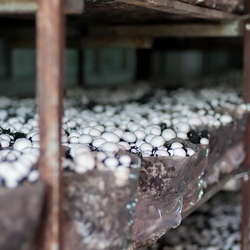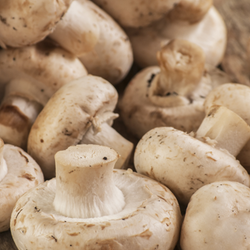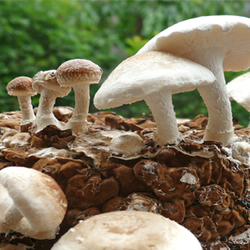I must admit, though, that--after compiling instructions--I haven't yet tried this. The only mushrooms I ever attempted to grow were morels outdoors. Nothing came of that. But, in my defense, I must add that morels are supposed to be one of the most difficult mushrooms to propagate. The instructions here are for common button mushrooms (Agaricus bisporus) which are reportedly much easier.
For the button mushrooms, you'll need fresh horse manure with straw, gypsum, burlap, large trays with drainage holes, button mushroom spawn, a spray bottle, and sieved garden soil. Get your horse manure in the fall, about four to six weeks before you intend to "plant" your spawn, from a stable that uses straw for bedding. Moisten the pile, sprinkle it with gypsum, and cover it with damp burlap. Turn the manure every few days--or at least once a week--covering it with the damp burlap again after you are done.
 Fill the trays after three to five weeks, when the manure has composted enough to turn dark brown and lose its odor. Professionals often use trays made from wood, steel, or polycarbonate that are two feet by three feet, and six to twelve inches deep. But you might get away with improvising! Fill them to within a couple inches of the top with the composted manure, and let it sit until its temperature has dropped to 70 degrees Fahrenheit.
Fill the trays after three to five weeks, when the manure has composted enough to turn dark brown and lose its odor. Professionals often use trays made from wood, steel, or polycarbonate that are two feet by three feet, and six to twelve inches deep. But you might get away with improvising! Fill them to within a couple inches of the top with the composted manure, and let it sit until its temperature has dropped to 70 degrees Fahrenheit.
Purchase one cup of spawn for every four square feet of compost. Buy it from a nearby seller, and ask for the inoculation date to make sure it is no more than two months old. Depending on the type of spawn you are using, you can either mix it into the top few inches of compost or break it into walnut-sized pieces and "plant" them six to ten inches apart and two inches deep.
 Keep the trays in a dim room or basement at 70 degrees for two to three weeks, misting them with water occasionally to keep them moist but not soggy. Lower the temperature to 60 degrees once the compost is covered with white "webs," and add an inch of sieved and moist garden soil to its surface. Top the trays with damp burlap or newspapers for ten days.
Keep the trays in a dim room or basement at 70 degrees for two to three weeks, misting them with water occasionally to keep them moist but not soggy. Lower the temperature to 60 degrees once the compost is covered with white "webs," and add an inch of sieved and moist garden soil to its surface. Top the trays with damp burlap or newspapers for ten days.
Remove the burlap or newspapers after ten days and begin misting the soil again. Watch for tiny white dots to appear in another five to ten days.
Begin picking the mushrooms about ten days after the dots appear, by twisting or cutting them off at the soil line. Continue picking the largest ones and they should produce for several months, though probably not as prolifically as in the photo of the mushroom farm! Keep the soil damp, but avoid getting water on the mushrooms, as that may cause them to turn brown.
 I'm guessing that fresh compost is preferred because the heating renders it temporarily sterile. So you could probably get away with sterilizing older composted manure instead. Keep in mind, however, that heating any kind of soil can be a stinky process!
I'm guessing that fresh compost is preferred because the heating renders it temporarily sterile. So you could probably get away with sterilizing older composted manure instead. Keep in mind, however, that heating any kind of soil can be a stinky process!
Chicken manure mixed with straw will reportedly work also, though horse manure is preferred. Although a basement isn't strictly necessary, you do need a room that is dim, humid, and can be kept cool after the initial warm period. I would run a fan occasionally to keep things from getting too dank, but never allow the soil to dry out completely or become waterlogged. After the mushrooms stop appearing, you can add the compost to your garden in the spring.
If anybody has tried this, please let me know how it worked out. Of course, I have the problem that my basement is already filled with grow lights. But maybe I could try sliding a mushroom tray or two under the plant tables. . .
Photos:
Thumbnail photo is by Johnny Boi, courtesy of stock.xchng . Horse manure photo is by Malene Thysson, compost photo by Kessler Photography, and mushroom farm photo by Andrew Bossi, all courtesy of Wikimedia Commons.
Sources:
"Growing Mushrooms;" Kansas State University
"Mushrooms: Grow Them at Home;" Cornell University
"Cultivated White Cap Mushrooms;" Thompson & Morgan
Growing Gourmet and Medicinal Mushrooms; Paul Stamets
















